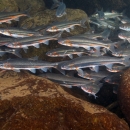
Hatchery upriver bright (URB) fall Chinook salmon are straying into the White Salmon River (Figure 1). ESA-listed tule fall Chinook population in the White Salmon River spawns earlier (Sept – Oct) than URBs (late Oct – Nov). Tule redds at risk to superimposition which may displace eggs and reduce egg-to-fry survival.
A surprisingly high incidence of tule redds monitored were superimposed by URBs in 2022 and 2023. Counts of redds superimposed from aerial surveys can be especially valuable for high-density spawning areas. Efficient processing of aerial imagery requires high performance computing environment. • Aerial drone surveys can provide high-resolution georeferenced imagery of a more expansive area of spawning grounds.
Next steps: Compare count estimates of redds superimposed from ground surveys with aerial surveys. Estimate aerial observer error among four independent observers. Prepare for 2024 aerial surveys using a Skydio X10 drone with onboard AI for obstacle avoidance.






